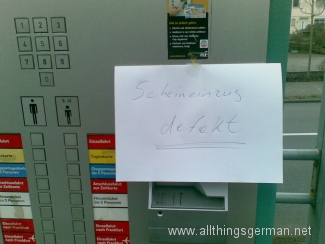A big thank you to whoever stuck this note onto our local ticket machine yesterday, and saving me a repeat of my previous experience!

Scheineinzug defekt
Please click on ACCEPT to give us permission to set cookies [more information]
This website uses cookies to give you the best browsing experience possible. Cookies are small text files that are stored by the web browser on your computer. Most of the cookies that we use are so-called “Session cookies”. These are automatically deleted after your visit. The cookies do not damage your computer system or contain viruses. Please read our privacy information page for more details or to revoke permission.